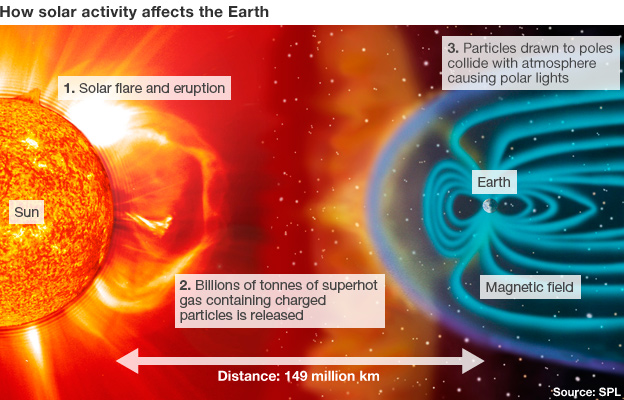
The most powerful solar storm in a decade hit our Planet Earth on March 8, and will create northern lights (auroras) far south of their usual range. More are reported to arrive.
On March 6, the sun produced two enormous X-class sun flares – the most powerful types of solar blasts to erupt from the sun’s surface – that flung waves of charged particles into space. The particle bursts are called coronal mass ejections, or CMEs, and as they hit Planet Earth’s atmosphere they can disrupt communication satellites and power grids. But the interaction of CMEs with Earth’s magnetic field also produces the incredible displays known as the northern lights or auroras.
Solar Flares caused by Solar Storms to alter life on Earth in March 2012 ?
When the solar storm reached Earth, it was slightly weaker than expected, and the alignment of Planet Earth’s magnetic field with the CME’s magnetism further weakened the storm. On the NOAA Space Weather Prediction Center’s Facebook page, the effect was likened to two bar magnets placed side-by-side with their poles misaligned. But NOAA goes on to note that the storm may take 24 hours to completely pass and could intensify further. Officials predict a ‘strong’ geomagnetic storm before the CME is finished.
It was the most potent solar storm since 2004, space weather forecasters stated. However no power outages or other technological disturbances were reported from the solar storm, which started to peter out yesterday.
Solar Flares caused by Solar Storms to continue
If the storm reaches predicted intensities, it could cause northern lights auroras as far south as geomagnetic latitude 50 which is not identical to geographic latitude. This includes in US most of the northeastern U.S., the upper Great Plains region, and Washington state. Your geomagnetic latitude can be traced at the SWPC website.
If you’re in line to potentially see the northern lights tonight, you can increase your chances by getting away from bright cities and looking for clear, cloudless skies. Any amateur photographers can send their best shots to us.
Solar System : Sun wakes up from a lull in its solar cycle : Increase in solar flares expected
The sun is currently waking up from a lull in its 11-year solar cycle. The next years should see raising activity, and there’s a real possibility of a dangerously strong solar storm occurring in the next decade. In addition to the double burst on March 6, another powerful X1.1-class flare erupted from the sun’s surface on March 4, but its CME missed Earth.
NASA has also installed an app that can send the most up-to-date space weather information directly to our smartphones. And more storms are expected to fall. The US Space Weather Prediction Centre indicates the same area of the sun erupted again late this week, with a milder storm expected to reach Earth on Sunday. Forecasters now have a new flare from the same sunspot region to observe. Preliminary forecasts show it to be slightly weaker than the one that just hit our little planet Earth.
[adrotate banner=”41″]
